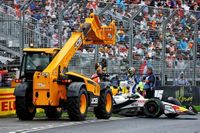In the aftermath of the chaotic Australian Grand Prix held on March 16, 2025, safety protocols in Formula 1 came under intense scrutiny as recovery vehicles were seen on the track during the race. This incident reignited discussions around the implementation of safety measures in motorsport, particularly in challenging environments such as the street circuit of Albert Park.
The race in Melbourne was marked by drama, with six cars failing to finish due to various incidents. Among those involved were rising stars Isack Hadjar, who crashed on the formation lap, and Jack Doohan, who exited the race shortly thereafter. Veteran competitors such as Carlos Sainz, Fernando Alonso, Gabriel Bortoleto, and Liam Lawson also found themselves in trouble during the event, leading to considerable laps behind the safety car.
As recovery vehicles entered the circuit to clear the wreckage, questions about safety and decision-making protocols emerged. The presence of recovery lorries in live traffic raised alarms among drivers and team personnel alike. Red Bull team principal Christian Horner criticized the practice, asserting that it is "never great seeing recovery cars on the circuit when the cars are circulating or there are still cars looking to close up," highlighting the precarious nature of racing under such conditions.
However, Alonso took a more measured approach to the criticism surrounding the recovery vehicles. Ahead of the upcoming Chinese Grand Prix, he remarked, "I don't know the exact details, so it's difficult to comment, but I think Melbourne is not an easy track to recover cars. So at one point, they need to go into the track." He emphasized that the situation was "under control," despite the valid concerns expressed.
Max Verstappen and Lando Norris backed Alonso's viewpoint, with Verstappen bluntly stating, “I mean, if you crash into that, behind the Safety Car, then you’re really stupid.” Norris echoed this sentiment, asserting, “You shouldn’t be in Formula 1” if drivers could not adhere to safety protocols. These comments reflect a shared sentiment among some competitors that responsibility ultimately falls on drivers to demonstrate caution.
Gabriel Bortoleto, a rookie driver for Sauber, also weighed in, agreeing with Alonso. He noted, “The double yellow area that you need to follow the delta, you go very, very slow there,” suggesting that the stewards implemented procedures to mitigate risks following the tragedy involving Jules Bianchi in 2014, when the driver struck a recovery vehicle during the Japanese Grand Prix.
Oliver Bearman, a fellow rookie, corroborated this understanding, asserting the decisions made by the stewards were prudent and reasoned given the circumstances, particularly in a damp environment that led to multiple spin-outs even among seasoned drivers.
This conflict underscores a significant rift in the approach to safety within Formula 1 racing. While the majority of drivers and teams acknowledge the importance of caution and adherence to protocol, the tension between maintaining race action and ensuring participants' safety continues to be a contentious issue. Horner’s concerns that recovery vehicles on-track can pose a hazard during racing are palpable, leading to calls for gamesmanship while still prioritizing the well-being of competitors.
As the F1 community reflects on the events of the Australian Grand Prix, the emphasis remains on improving regulations and protocols. After all, racing can be a dangerous sport; ensuring that such dangerous situations are addressed is critical not just for the athletes on the track, but also for the integrity of the sport itself.
Notably, the recovery of Alonso's crashed Aston Martin further illustrates the difficulties of recovery operations on street circuits. During the Australian Grand Prix, he remarked, "I think we have now a different system than what we had in the past... if you respect that time, you should not be too fast in that zone"—a comment reflecting his understanding of the nuances involved in operating under safety conditions while navigating the complications unique to street circuits.
The aftermath of the Australian GP showcases how vital communication is between teams, drivers, and officials when it comes to safety protocols. Given the established precedent following Bianchi's tragic accident, F1 authorities are expected to further scrutinize their processes to protect drivers while still retaining the thrilling nature of the sport.
Moving forward, F1 officials may look to adjust protocols to ensure optimal safety standards are met without compromising the excitement or integrity of racing. As the sport evolves, addressing these pressing concerns will be paramount.






